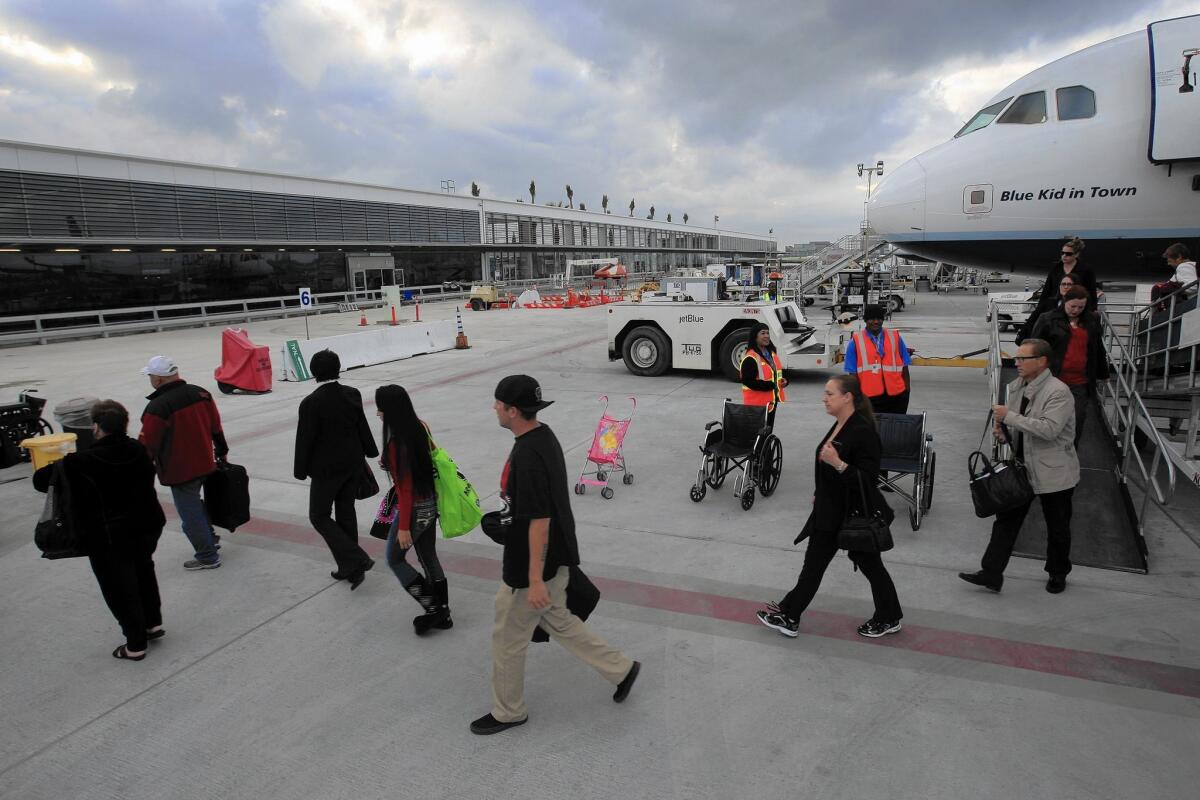Southwest’s Long Beach Airport takeoff could spur fresh rivalry with JetBlue

Michael Spann can drive from his home to the Long Beach Airport in less than 15 minutes, but the sales representative is frustrated that he can’t get a direct flight to see his son in Denver from the handful of carriers that serve the regional airfield.
That could change now that the city of Long Beach has offered Southwest Airlines the chance to operate in Long Beach for the first time, setting up a possible battle of low-cost carriers at the 1,166-acre facility.
“I welcome Southwest coming in because it gives me more options,” Spann said.
Long Beach’s move to add nine new daily departures and arrivals boosts airport traffic up to 20%. It also opens the door for JetBlue Airways, the biggest carrier at Long Beach with more than 80% of the daily flights, to go head-to-head with Southwest, a low-cost carrier known to dominate its competitors at regional airports.
See more of our top stories on Facebook >>
“It’s an opportunity for Southwest to enhance their network even if it is a few slots,” said Jonathan Root, an analyst with Moody’s Investor Service.
Southwest executives have yet to announce the destinations they would like to serve from Long Beach but they have hinted that Southwest may add flights to the Bay Area — possibly duplicating the routes now served by JetBlue.
The new slots for daily flights became available after noise studies in November showed that the airport could add nine more daily departures and arrivals without violating an airport noise limit that sets a threshold tied to the airline noise generated in 1989-90.
Experts say the growing use of modern jets with quieter engines, among other factors, has helped reduce airport noise in Long Beach and other airports across the country.
Until Long Beach added the new slots, the airport imposed a limit of 41 daily flights for large jets, allocated to JetBlue, American Airlines, Delta Air Lines, Federal Express and UPS. The city distributed the nine new slots by offering four to Southwest, three to JetBlue and two to Delta.
For now, the airport serves only domestic destinations, but Long Beach is now considering adding a federal inspection facility to allow international flights. JetBlue has been lobbying for the inspection facility so it can open routes out of Long Beach to Mexico.
In neighborhoods around Long Beach Airport, residents have mixed views about the growth, with some praising the city for bringing in more travel alternatives and others worrying that it may lead to more jet noise.
“It’s about convenience and more choices,” said Suzanne Powell, a retired teacher who has lived in Long Beach for 10 years.
Some residents who live near the airport say they prefer quiet skies to increased airline competition.
“We are close enough to flight paths to hear the takeoffs,” said Ron Antonette, a public relations consultant who lives less than three miles from the airfield. “They are studying adding international flights now, and there are a lot of unknown variables.”
Laurie Smith, a television producer who lives about two miles from Long Beach Airport, noted that federal officials have begun installing a modernized air traffic control system, known as NextGen, at the airport. She suggests that the city postpone adding more slots until the impact of the new traffic control system is studied.
Long Beach is one of the smallest airports that operates scheduled commercial flights in Southern California. In the 12 months that ended Nov. 30, the airport served 1.2 million passengers, an 11% decline from the same period in 2014, according to federal data.
The decline is partly the result of airline mergers over the last decade. The combinations have consolidated the nation’s domestic service to a handful of mega-carriers that have cut less-profitable routes to smaller airports to focus on more lucrative flights to large hub airports.
In addition, JetBlue hasn’t taken full advantage of its Long Beach slots as it focuses on its growing business to the Caribbean and Latin America, Fitch Ratings has noted. But JetBlue has denied that the reduction in daily flights out of the regional airport is tied to delays in allowing international flights.
Airline industry experts say the move by Southwest to open operations in Long Beach may seem strange, considering the size of the facility and the decline in passenger traffic over the last few years.
But they note that Southwest’s business strategy has long been to concentrate operations at regional airports, leaving its competitors to battle over major hub airports like Los Angeles International Airport, the nation’s third-busiest airport.
“It’s part of being what they call a neighborhood airline,” said Henry Harteveldt, chief research officer and co-founder of San Francisco-based Atmosphere Research Group.
In Southern California, major carriers such as American, Delta and United Airlines have been investing heavily to dominate at LAX. Delta, for example, last year completed a $229-million upgrade to its LAX facilities. American Airlines announced plans last month to add 25 daily flights out of LAX starting in June, a 10% increase in service for the Fort Worth-based carrier.
Meanwhile, Southwest has grown to be the largest carrier in most regional airports around LAX, including Bob Hope Airport in Burbank, John Wayne Airport in Santa Ana, Ontario International Airport and San Diego International Airport.
Of Southern California’s regional airfields, Long Beach Airport has been one of the few facilities not served by Southwest.
“We want to be L.A.’s preferred carrier, not just the largest,” Southwest spokesman Brad Hawkins said. “By having service in multiple locations we reach different groups of customers.”
Industry experts say that advances in jet engine technology could continue to lower the noise impact at Long Beach, allowing the city to add even more air traffic in the future.
For now, Long Beach officials say they can’t predict whether more slots will be added in the next few years. But if the airport continues to expand service, Southwest officials hope to be in a position to take advantage of the growth.
“We have the strongest customer base in California, I would venture to say, and we aim to be everywhere they want to fly,” Hawkins said.
Twitter: @hugomartin
MORE BUSINESS NEWS
Does Apple win even if it loses?
Slack founder seems surprised by its runaway success
With changes to Starbucks rewards program, small spenders lose out
More to Read
Inside the business of entertainment
The Wide Shot brings you news, analysis and insights on everything from streaming wars to production — and what it all means for the future.
You may occasionally receive promotional content from the Los Angeles Times.











